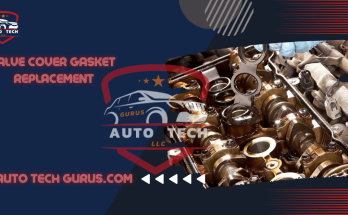Valve Cover Gasket Replacement
The internal engine in a vehicle is a complex system composed of numerous components that must work in harmony for safe and efficient operation. One often overlooked but vital component is the valve cover gasket.
However, problems can arise after valve cover gasket replacement if the procedure is not executed correctly. The most common issues following valve cover gasket replacement include oil leaks, misaligned or damaged gaskets, improperly tightened bolts, damaged valve covers, and misfiring. These problems may result from improper installation or a defective gasket. To avoid these issues, it’s crucial to ensure that the gasket is correctly aligned and tightened according to the manufacturer’s specifications and that all bolts and components are securely fastened.
The valve cover gasket serves the critical role of sealing the valve cover, preventing oil leaks, and safeguarding the engine’s internal components. Unfortunately, many drivers fail to recognize the importance of the valve cover gasket until it malfunctions or causes engine damage. In such cases, replacing the gasket becomes necessary, leading to additional expenses in both time and money. Therefore, proper installation and maintenance of the valve cover gasket are essential to ensure the longevity and performance of the engine.
Understanding the Valve Cover Gasket in an Engine
A valve cover gasket plays a crucial role in the functioning of a vehicle’s engine. Here’s a summary of its key functions and benefits:
- Sealing Function: The valve cover gasket serves as a barrier between the valve cover and the engine block, ensuring that oil and other contaminants do not leak out of the engine. Its primary task is maintaining a secure seal and preventing oil leakage that can harm engine performance.
- Material and Durability: Valve cover gaskets are typically crafted from rubber, cork, or silicone materials. Choosing materials that can withstand high temperatures and pressures inside the engine ensures the gasket’s durability.
- Oil Leak Prevention: By creating a secure connection between the engine and valve cover, the gasket effectively contains the engine oil, preventing potential leaks that could lead to oil loss and engine damage.
- Protection Against Contaminants: Besides sealing against oil leaks, the valve cover gasket also acts as a protective shield for engine components. It prevents harmful contaminants like dust, dirt, and debris from infiltrating the engine, preserving its longevity and performance.
- Maintenance of Oil Pressure: The valve cover gasket maintains the correct oil pressure within the engine. Proper oil pressure is vital for the overall performance and lifespan of the engine, ensuring that it operates smoothly and efficiently.
A valve cover gasket is a critical component that helps maintain the engine’s integrity by preventing oil leaks, protecting against contaminants, and supporting optimal oil pressure. Its role is vital for the safe and efficient operation of the vehicle’s internal combustion engine.
The Cost of Replacing a Valve Cover Gasket
When facing a damaged or malfunctioning valve cover gasket, it’s natural to wonder about the cost of repair or replacement. Understanding the potential costs is indeed essential. Here’s a summary of key points regarding the cost of valve cover gasket replacement:
- Cost Variation: The valve cover gasket replacement cost can vary significantly and typically falls between $150 to $550 or even more. The cost depends on the vehicle’s make and model, parts variations, and the mechanic’s labor charges.
- Vehicle Models: Different car models may have varying complexities in their engine design, affecting the difficulty and time required for gasket replacement, which can impact the cost.
- Mechanic’s Assistance: The choice of mechanic and their hourly labor rates can significantly influence the overall cost of the repair. Experienced or specialized mechanics may charge higher rates.
- Location: The location of the service can also affect the cost. In metropolitan areas and towns, the cost of repairs is generally higher compared to rural or less populated areas.
it’s crucial to know that valve cover gasket replacement costs can fluctuate based on various factors, including the vehicle’s model, parts, mechanic’s rates, and location. Conducting research and obtaining quotes from reputable mechanics in your area can help you get a more accurate estimate for the specific repair job required for your vehicle.
Problems After Valve Cover Gasket Replacement
Experiencing issues after replacing your valve cover gasket is a common occurrence. Recognizing these critical symptoms associated with valve cover gasket problems is essential. Awareness of these problems can guide you in taking the necessary steps to address them promptly and save on valve gasket replacement costs.
Here are typical issues that may arise after replacing your valve cover gasket:
- Oil Leaks: If you’ve recently replaced your valve cover gasket and notice oil spots beneath your vehicle, it’s possible that the replacement was not done correctly. Oil leaks can also occur due to other factors, such as worn or damaged seals and gaskets. Therefore, you should rule out these other possibilities before concluding that the problem is with the replaced accessory. Low oil levels resulting from leaks can cause components within the engine to rub against each other, leading to damage and reduced engine efficiency.
- Slipping Out of Place: A properly installed gasket should fit tightly and securely. However, if it slips out of place, this indicates a problem with the replacement process. Several factors, including improper installation techniques or exposure to high temperatures and harsh conditions, can contribute to slipping. When the gasket slips, it may lead to oil leaks and other mechanical problems that require prompt attention to prevent further damage.
- Poor Quality Material: In today’s market, counterfeit car accessories, including valve cover gaskets, are prevalent. Gaskets made from substandard materials may have a shorter lifespan than expected. Many car owners find themselves needing to replace the gasket prematurely due to this reason. Additionally, low-quality materials can result in the gasket rusting or wearing quickly, leading to malfunctions that could cause significant engine damage.
- Bolt Variations: The bolts used to secure the valve cover gasket vary in size among vehicle brands and models. In some instances, the person conducting the replacement may need access to the correct bolts or may use bolts of the incorrect size. Furthermore, some bolts can be omitted during the replacement process, compromising the gasket’s seal. Incomplete bolt placement can prevent the gasket from maintaining a tight seal.
- Wrong Direction Tube Sealing: The tube connecting the valve cover is crucial in directing oil and air to the engine. If it’s not sealed properly, air can enter the engine in the wrong direction, disrupting the air-fuel mixture. It can result in a lean air-fuel mixture, causing engine performance issues or even the risk of engine fires.
Addressing these issues promptly and accurately is essential to maintain your vehicle’s engine’s proper functioning and safety. Suppose you experience any issues following a valve cover gasket replacement. In that case, it is recommended to seek the help of a certified mechanic for a complete diagnosis and proper solutions.
FAQ’s About Valve Cover Gasket Replacement
Why does my valve cover keep leaking after replacement?
There could be a few different reasons why. For one, it’s possible that the gasket was initially installed incorrectly.
Another possibility is that the bolts securing the gasket in place are too loose, causing the gasket to shift and result in leaks.
What happens if you replace the valve cover gasket?
After replacing the gasket, the engine should operate significantly better, with improved efficiency. There will also be a reduced risk of oil leaks and engine damage, ultimately extending the life of your vehicle.
Should you change the oil after changing the valve cover gasket?
While it’s unnecessary to change the oil immediately after replacing the valve cover gasket, it’s advisable to consider doing so. During the replacement process, small debris particles could enter the engine. Changing the oil can help remove this debris, improving the engine’s overall health and longevity.
How long should a replaced valve cover gasket last?
The lifespan of the newly installed valve cover gasket can vary based on several factors. Generally, a high-quality gasket made from durable materials and installed correctly should last several years.
How long should you wait to drive after replacing the valve cover gasket?
Typically, waiting at least 30 minutes to an hour before driving your vehicle would be best. It allows the gasket to settle properly into place.
Why is it important to use new oil on the gasket?
Using fresh oil ensures the engine receives proper lubrication, preventing wear and tear on internal components.
What type of gasket is best for valve covers?
The choice of the best gasket for your valve cover depends on the specific requirements of your engine and the operating conditions it encounters.



